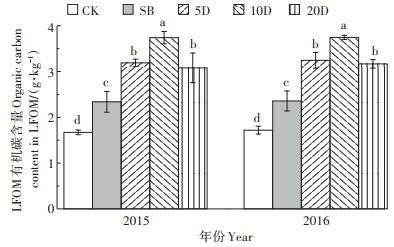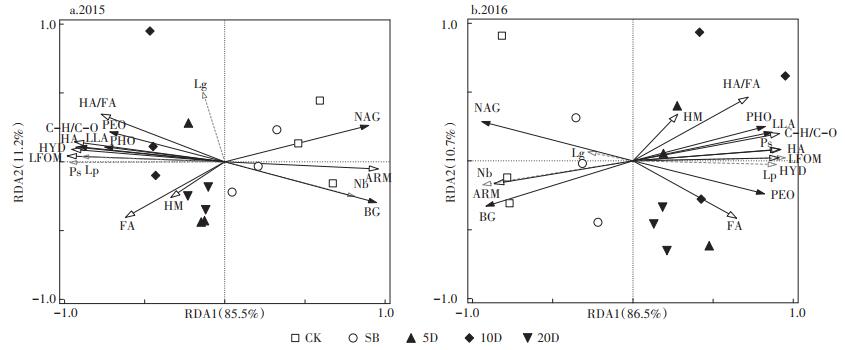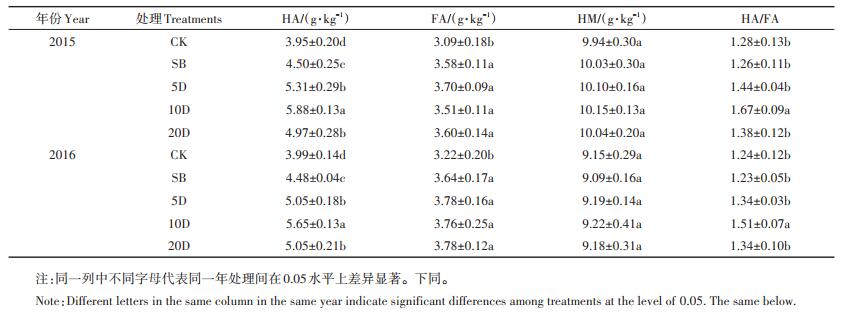2. 长江大学/长江大学主要粮食作物产业化湖北省协同创新中心, 湖北 荆州 434023
2. Hubei Collaborative Innovation Center for Grain Industry, Yangtze University, Jingzhou 434023, China
水稻(Oryza sativa L.)是我国最重要的粮食作物之一,其种植面积占全国粮食作物总面积的26.7%[1]。免耕作为一种新型保护性耕作措施近年来被广泛应用于我国水稻生产[2-4]。农民常通过表施氮肥提高作物产量。有研究表明,氮肥表施会造成氮素的大量损失[5-7]。与传统氮肥表施相比,氮肥深施可以促进作物生长,提高作物产量。Ibrahim等[8]发现氮肥深施10 cm通过增加作物根系体积促进作物对营养元素的吸收,最终提高作物产量。还有研究表明,氮肥深施可以提高氮肥利用率,减少氮素损失。Rychel等[9]研究指出,氮肥深施20 cm显著提高作物的含氮量并降低土壤氧化亚氮排放量。Wu等[10]研究也发现,氮肥深施通过促进作物对氮肥的吸收提高氮素利用率。因此,近年来氮肥深施在我国免耕稻田生产中得到了大面积推广[11]。
土壤有机质是植物养分的主要来源,是衡量土壤肥力的重要指标[12]。研究已表明,土壤有机质含量与作物产量显著正相关[12-13]。耕作和施肥等农业措施影响着土壤有机质的含量和质量。有研究发现,保护性耕作较传统翻耕提高了土壤有机质的含量,促进了有机碳的固定[14-16]。同时,研究表明,施肥措施显著影响土壤有机质的含量及性质[17-18]。氮肥深施作为一种高效的氮肥施用方式显著影响着土壤有机质。Zhang等[19]研究指出,氮肥深施可以显著提高土壤有机质的含量;Liu等[20]发现氮肥深施可以降低土壤有机质的分解速率。在众多土壤理化特性中,有机质的化学组成和性质对土壤肥力和养分循环起决定性作用[21-22],因此不同施肥措施对土壤有机质化学特性的影响一度成为研究热点。如史吉平等[23]发现长期施用有机肥或有机无机肥配施会改变土壤腐植酸中各化学官能团的组成和含量,Francioso等[24]的研究结果表明施用粪肥会显著提高土壤有机质中脂肪族和芳香族化合物的含量。然而,当前有关氮肥深施对土壤有机质化学组成与性质影响的研究寥寥无几。因此,探讨氮肥深施对免耕稻田土壤有机质化学特性的影响,对于明确氮肥深施调控土壤肥力和生产力的机制以及对其作出相应的改善对策具有重要意义。
土壤有机质按化学组成可分为腐殖质和非腐殖质两大类。腐殖质由新鲜有机质经微生物分解转化形成,属于较稳定的惰性有机质,主要由胡敏素(Humin,HM)、胡敏酸(Humic acid,HA)和富里酸(Fulvic acid,FA)组成[25]。腐殖质含有羟基、羧基、羰基、甲氧基等多种官能团,这些官能团的含量和占比共同决定腐殖质的化学稳定性和作用[26],也是影响土壤肥力的重要因素[27-28]。HA是腐殖质中最活跃的成分,在一定程度上表征腐殖质的芳香性、化学稳定性和有效性,其含量越高,表明腐殖质的活性越高,品质越好[29]。因此,研究HA含量、化学结构与性质的变化可以揭示腐殖质以及土壤肥力的变化情况。非腐殖质包含小分子有机化合物、可溶性有机碳(DOC)和微生物量碳(MBC)等,属于易分解的活性有机质,对植物养分的供应有最直接的作用[30-31]。相对密度低于2 g·cm-3、主要源于未分解及半分解植物残体和部分微生物体的轻组有机质(Light fraction organic matter,LFOM)占活性有机质总含量的76%~96%[32],因此通过测定LFOM的含量与化学组成可以反映土壤活性有机质及土壤肥力的情况。
本试验旨在通过比较传统表施和氮肥深施之间的差异,明确氮肥深施措施对免耕稻田土壤有机质化学组成和性质的影响机制。本研究假设,与传统表施相比,氮肥深施通过调控作物生长和土壤微生物活性改变土壤惰性和活性有机质的含量与化学特性,改变免耕稻田土壤有机质的质量和有效性,最终影响土壤肥力和生产力。为了验证该假设,本试验采用13C核磁共振(Nuclear magnetic resonance,NMR)和热裂解气相色谱/质谱联用法(Pyrolysis-gas chromatography/ mass spectrometry,Py-GC/MS)研究土壤有机质的化学特性,通过β-葡萄糖苷酶(β-glucosidase,BG)、β- N-乙酰氨基葡糖苷酶(β-N-acetylglucosaminidase,NAG)、L-亮氨酸氨基肽酶(L-leucine aminopeptidase,LLA)、酚氧化酶(Phenol oxidase,PHO)和过氧化物酶(Peroxidase,PEO)5种酶的活性来反映土壤酶活性、能提,通过冗余分析(Redundancy analysis,RDA)研究土壤有机质各组分化学特性与土壤酶活之间的关系。
1 材料与方法 1.1 试验地情况在湖北省武穴市花桥镇现代农业示范中心试验基地(30°00′ 48″ N,115°47′ 16″ E,海拔19 m)开展大田试验。该地区属于亚热带湿润季风气候,年平均气温17.8 ℃,年平均降雨量1 361 mm,年平均日照时长约260 d,土壤为潜育土(FAO土壤分类)。从2011年6月起直至本试验开展期间,该试验田一直进行水稻(黄华占)-油菜(华双3号,Brassica napus L.)免耕复种。试验田本底土(0~20 cm)理化性质如下:pH 5.36,总有机碳含量20.92 g·kg-1,总氮含量2.06 g· kg-1,铵态氮含量8.48 mg·kg-1,硝态氮含量0.59 mg· kg-1,总磷含量2.36 g·kg-1,总钾含量3.77 g·kg-1,土壤容重1.08 g·cm-3。
1.2 试验设计与大田管理试验处理包括不施肥(CK)、氮肥传统表施(SB)、以及氮肥深施5 cm(5D)、10 cm(10D)和20 cm(20D),采取随机区组设计,3次重复。小区面积36 m2(长8.0 m,宽4.5 m),每小区设两个厢(长7.4 m,宽1.8 m)。为方便灌溉和排水,在厢和小区四周挖掘沟渠(宽0.3 m,深0.25 m)。为防止水肥串流,小区之间用田埂(宽0.4 m,高0.4 m,覆盖塑料薄膜)和保护行(宽1 m)隔开。试验田总面积1 207.5 m2(长35 m,宽34.5 m),四周设置围沟和保护行,以方便田间管理。
水稻在每年6月进行人工抛秧(1.8 × 105穴· hm-2),10月收获。水稻生育期施肥总量为180 kg N· hm-2、90 kg P2O5·hm-2和180 kg K2O·hm-2,选用复合肥(N∶P2O5∶K2O=15%∶15%∶15%)、尿素(含氮量46%)以及氯化钾(K2O含量60%)作为肥料。全部磷肥作为基肥一次性施用;钾肥一半基施,一半在拔节期追施;氮肥分别在秧苗期、分蘖期、拔节期和孕穗期施用总量的50%、20%、12% 和18%,其中基肥为复合肥,追肥为尿素。为了尽量减少肥料施用对土壤的物理扰动,本试验采用SB-13B3型半自动深施施肥器(台州市农乐塑料有限公司,中国)进行肥料深施,施肥点位于水稻之间,施肥点间距约20 cm。每年6月上旬在稻田淹水前喷洒30%丙草胺乳油除草,其他时期进行人工除草。水稻生育期内采取间歇灌溉,维持田间水面在4~8 cm的深度。油菜分别在每年10月和来年5月进行直播和收获,同样采用免耕栽培。油菜生育期总施肥量为180 kg N·hm-2、90 kg P2O5·hm-2和150 kg K2O·hm-2,所用肥料类型与水稻一致。在油菜苗期氮肥总量的一半进行深施,其余氮肥则在抽薹期和开花期进行表施。水稻和油菜季秸秆全部粉碎后覆盖还田。
1.3 土壤采集与测定在每年的水稻收获期采集土壤样本。每个小区随机选取5个采样点,用内径7 cm的取土器采集0~ 20 cm深的土样,将来自同一小区的土样装入密封袋内形成混合样本并立刻运回实验室进行处理。挑出土样中的石头和动植物残体后将其轻轻捏碎并充分混匀,分成两个子样本,一个子样本保存在-20 ℃下用于有机质化学特性的测定,另一个子样本冷藏于-80 ℃下用于土壤酶活的测定。
土壤有机质各组分的有机碳含量通过重铬酸钾外加热法测定[33]。用氢氧化钠(NaOH)-焦磷酸钠(Na4P2O7)提取法分离和提取土壤腐殖质中的HA、FA和HM[34]。利用固体交叉极化/魔角旋转(CP/MAS)13CNMR光谱法对HA的主要化学官能团结构及组成进行测定。通过浮选法从土壤中分离提取LFOM[35-36]。参考Saiya-Cork等[37]的方法对土壤中5种胞外酶(BG、NAG、LLA、PHO和PEO)的活性进行测定。
1.4 数据处理与分析在对数据进行正态分布和方差齐性检验后,在SPSS 22.0中进行单因素方差分析(ANOVA),对处理影响显著的数据进行Turkey HSD检验以两两比较不同处理间的影响差异。用OriginPro(2017版)进行绘图,用Canoco(5.0版)进行RDA分析。所有统计分析的显著性水平都为P < 0.05。
2 结果与分析 2.1 腐殖质各组分的有机碳含量氮肥施用措施显著影响腐殖质中HA和FA的有机碳含量以及二者的比例HA/FA(表 1)。与SB相比,氮肥深施下HA的有机碳含量显著高10.4%~30.7%(P < 0.05);在氮肥深施处理中,与5D和20D相比,10D下HA的有机碳含量显著提高10.7%~18.3%(P < 0.05)。此外,SB、5D、10D和20D下FA的有机碳含量之间都没有显著差异。与SB相比,10D下的HA/FA显著高22.8%~32.5%(P < 0.05);氮肥深施处理中,10D下的HA/FA比5D和20D显著高12.7%~21.0%(P < 0.05)。氮肥施用措施对HM的有机碳含量没有显著影响。
|
|
表 1 2015和2016年水稻收获期免耕稻田在不同施肥处理下土壤腐殖质中各组分有机碳的含量 Table 1 Organic carbon contents in different humic substances under different treatments in no-tillage paddy fields at harvest stages in 2015 and 2016 |
氮肥施用措施对LFOM的有机碳含量有显著影响(图 1)。与SB相比,氮肥深施处理下LFOM的有机碳含量显著提高1.7%~53.5%(P < 0.05);在氮肥深施处理中,与5D和20D相比,10D下的LFOM有机碳含量显著升高2.5%~16.5%(P < 0.05)。

|
图 1 2015和2016年水稻收获期免耕稻田在不同施肥处理下LFOM的有机碳含量 Figure 1 Organic carbon contents in LFOM in no-tillage paddy fields under different treatments at harvest stages in 2015 and 2016 |
氮肥施用措施对HA的化学特性有影响(表 2)。与SB相比,氮肥深施下烷基碳和羰基碳的含量、二者的比例以及HA的疏水性分别提高3.9%~23.3%、16.7%~225.0%、5.9%~43.7% 和1.0%~11.1%,烷氧碳、芳香碳和芳香氧碳的含量以及HA的芳香性则分别降低0.9%~15.2%、1.8%~25.0%、2.3%~27.8% 和4.3%~21.7%;此外,与SB相比,5D和10D下羧基碳的含量高2.0%~5.9%,20D下羧基碳的含量则低1.1%~ 2.0%。氮肥深施处理中,与5D和20D相比,10D下烷基碳、羧基碳、羰基碳、烷基/烷氧以及HA的疏水性分别高12.1%~17.6%、0.2%~7.0%、32.7%~178.6%、23.8%~35.4% 和6.4%~10.0%,而烷氧碳、芳香碳和芳香氧碳的含量以及HA的芳香性分别低9.5%~13.4%、4.7%~18.1%、17.0%~24.0%和10.0%~18.2%。
|
|
表 2 2015和2016年水稻收获期免耕稻田在不同氮肥施用措施下HA中各化学官能团的相对含量(%) Table 2 Relative abundance of different chemical functional groups in HA in no-tillage paddy fields under different treatments at harvest stages in 2015 and 2016(%) |
LFOM中多糖类化合物的相对含量最高,木质素次之,其次是含氮化合物,脂质的相对含量则最低(表 3)。氮肥施用措施对LFOM的化学组成有显著影响。与SB相比,氮肥深施下多糖和脂质的含量分别显著增加9.0%~24.1%(P < 0.05)和43.2%~68.2%(P < 0.05),10D下含氮化合物的含量则显著减少31.1%~32.9%(P < 0.05)。在氮肥深施处理中,与5D和20D相比,10D下多糖的含量显著提高7.9%~12.4%(P < 0.05),含氮化合物的含量则显著降低31.5%~34.0%(P < 0.05)。此外,氮肥施用措施对木质素的含量没有显著影响。
|
|
表 3 2015和2016年水稻收获期免耕稻田在不同氮肥施用措施下LFOM中各主要化合物的相对含量(%) Table 3 Relative abundance of dominant compounds in LFOM in no-tillage paddy fields under different treatments at harvest stages in 2015 and 2016(%) |
氮肥施用措施对土壤中各胞外酶的活性都有显著影响(表 4)。与SB相比,氮肥深施下BG和NAG的活性分别显著降低22.2%~48.8%(P < 0.05)和32.6%~ 40.4%(P < 0.05),10D下LLA和PHO的活性则分别显著提高37.1%~38.5%(P < 0.05)和11.1%~16.0%(P < 0.05)。氮肥深施处理中,10D下BG的活性在2015年比5D和20D显著降低29.3%~30.3%(P < 0.05),在2016年只比20D显著降低31.8%(P < 0.05);10D下LLA的活性则比5D和20D显著提高25.5%~36.2%(P < 0.05);此外,10D下PHO的活性在2015年比5D和20D显著提高9.5%~13.1%(P < 0.05),在2016年则只比20D显著提高11.4%(P < 0.05)。氮肥施用措施对PEO的活性没有显著影响。
|
|
表 4 2015和2016年水稻收获期免耕稻田在不同氮肥施用措施下土壤的酶活性(nmol·h-1·g-1) Table 4 Enzyme activity in soil in NT paddy fields under different treatments at harvest stages in 2015 and 2016(nmol·h-1·g-1) |
RDA结果表明,氮肥深施尤其是氮肥深施10 cm对土壤酶活有显著影响(图 2)。各胞外酶与HA、HA/ FA、C-H/C-O、HYD和ARM密切相关。HA、HA/FA、C-H/C-O、HYD、ARM与LLA、PHO、PEO呈正相关,与BG、NAG呈负相关。另外,LFOM、Ps、Lp与LLA、PHO、PEO呈正相关,而与BG、NAG呈负相关;与之相反的是,Nb与BG、NAG呈正相关,而与LLA、PHO、PEO呈负相关;此外,Lg与NAG呈正相关,但与其他胞外酶相关性较低。

|
腐殖质各组分的有机碳含量与化学性质用黑色实线空心箭头表示,轻组有机质的有机碳含量与化学组成用灰色虚线空心箭头表示,土壤各胞外酶的活性用黑色实心箭头表示;不同处理下的单个样本用不同形状的数据点表示。HA:胡敏酸,FA:富里酸,HM:胡敏素,HA/FA:胡敏酸和富里酸的比例,CH/C-O:烷基碳和烷氧基碳的比例,HYD:疏水性,ARM:芳香性;LFOM:轻组有机质,Ps:多糖,Nb:含氮化合物,Lg:木质素,Lp:脂质;BG:β-葡糖苷酶,NAG:β-N-乙酰氨基葡糖苷酶,LLA:L-亮氨酸氨基肽酶,PHO:酚氧化酶,PEO:过氧化物酶 Organic carbon contents and chemical properties of humic substances are denoted by black hollow arrows, organic carbon contents and chemical compounds in LFOM aere denoted by gray dashed hollow arrows, and extracellular enzyme activity is denoted by black solid arrow. Individual samples under different treatments are denoted by data points in different shapes. HA, humic acid; FA, fulvic acid; HM, humin; HA/FA, ratio of HA to FA; C-H/C-O, ratio of alkyl carbon to alkoxy carbon; HYD, hydrophobicity; ARM, aromaticity; LFOM, light fraction organic matter; Ps, polysaccharide; Nb, N-bearing compound; Lg, lignin; Lp, lipid. BG, β-glucosidase; NAG, β-N-acetylglucosaminidase; LLA, L-leucine aminopeptidase; PHO, phenol oxidase; PEO, peroxidase 图 2 2015年和2016年水稻收获期免耕稻田在不同氮肥施用措施下土壤中有机质的化学组成和性质与土壤酶活之间的关系 Figure 2 Relationships among the chemical composition and properties of soil organic matter fractions and enzyme activity in soil in no-tillage paddy fields under different treatments at harvest stages in 2015 and 2016 |
有研究表示,HA是腐殖质中活性最高的成分,可以和无机微量元素螯合形成有机盐而免于淋失,是植物运输营养物质和水分的重要介质;此外,它也可以和土壤黏粒结合形成稳定的聚合体,提高土壤物理结构的稳定性,因此HA对促进作物生长以及提高土壤肥力和质量都有很大的作用[38-39]。HA的积累也意味着土壤腐殖化程度的提高[26]。本研究结果显示,与传统表施相比,氮肥深施显著提高免耕稻田土壤腐殖质中HA的有机碳含量以及HA和FA的比例(表 1),说明氮肥深施特别是深施10 cm可以显著提升腐殖质的品质和土壤的肥力。Zhang等[40]研究也发现,施用氮肥能提高土壤HA的有机碳含量。HA主要是植物的凋落物、根系等经微生物降解转化而形成[41-42],因此氮肥深施能激发作物生长,从而促使更多植物残体、凋落物或作物残茬和秸秆输入土壤[43],导致腐殖质中HA有机碳含量及其在腐植酸中比例的上升。同理,本研究中氮肥深施10 cm下HA的有机碳含量比深施5 cm和20 cm时更高(差异显著,表 1),其原因可能是深施10 cm比深施5 cm和20 cm对作物生长的促进作用更强[44]。
本研究表明,氮肥深施显著改变免耕稻田土壤腐殖质的化学性质(表 2)。与传统表施相比,氮肥深施尤其是深施10 cm提高了HA中烷基碳的含量和HA的疏水性(表 2)。烷烃属于土壤碳库中一种较难分解的脂肪族化合物,其疏水性对土壤有机质的分解和稳定性起着至关重要的作用[45],因此氮肥深施下烷基碳含量以及HA疏水性的升高说明氮肥深施相对于传统表施更有利于土壤腐殖质化学稳定性的提高。然而,本研究发现氮肥深施下芳香族碳含量以及HA的芳香性都显著降低(表 2),意味着HA中复杂有机化合物的减少,化学结构变简单[29]。与之类似的是,Řezáčová等[46]也发现施肥会降低土壤腐殖质的芳香性和分子量。这可能是氮肥深施下更多的外源碳氮输入激发了特定土壤微生物群落的活性[44],从而促进了其对芳香族化合物的氧化分解。此外,本研究结果表明,氮肥深施10 cm土壤PHO的活性比深施5 cm和20 cm更高(表 4),而PHO酶催化反应的底物酚类属于芳香族化合物,导致本研究中深施10 cm HA的芳香性比深施5 cm和20 cm更低(表 2),RDA结果中PHO活性与HA芳香性呈显著负相关,进一步支撑该推论(图 2)。
3.2 氮肥深施对LFOM的有机碳含量及化学组成的影响本研究发现,与传统表施相比,氮肥深施显著提高了免耕稻田LFOM的有机碳含量(图 1),而LFOM与微生物生长和营养供给紧密相关[47-48],因此该结果表明氮肥深施可以通过改变LFOM的含量来提高土壤肥力。同样,有很多研究发现长期施肥会提高土壤中活性有机质的有机碳含量[49-51]。这是因为LFOM等活性有机质更易被微生物分解利用且周转速率更高,因此更易受到施肥等农业管理措施的影响[52];此外,LFOM主要来源于植物和微生物残体[53-54],因此,氮肥深施相对于传统表施能促进作物生长,从而提高作物残茬、凋零物、秸秆的还田,并激发土壤微生物活性,提高LFOM有机碳含量[43]。同理,氮肥深施10 cm比深施5 cm和20 cm显著提高作物生长与微生物群落丰度[44]也可能是本研究中深施10 cm时LFOM有机碳含量比深施5 cm和20 cm更高(差异显著,图 1)的原因。
本研究发现,氮肥深施显著影响免耕稻田LFOM的化学组成。与传统表施相比,氮肥深施提高LFOM中多糖和脂质的含量,而降低含氮化合物的含量(表 3)。氮肥深施下多糖的增多一方面可能是因为氮肥深施促进作物的生长,促使更多的植物残茬、秸秆和凋落物等外源碳的输入;另一方面氮肥深施对微生物活性的激发也会导致更多糖的产生[43, 55];此外还可能是因为氮肥深施下土壤DOC和MBC等小分子活性有机碳的增加使得微生物对多糖等大分子有机碳源的需求降低,即减少微生物对多糖的分解利用,导致LFOM中多糖含量增加[43, 56]。氮肥深施下BG和NAG的显著降低以及BG和NAG活性与多糖含量的负相关都进一步论证了这一点(表 4和图 2)。同理,与深施5 cm和20 cm相比,氮肥深施10 cm提高作物生长、微生物群落丰度及小分子活性有机碳含量[44],这也可能是导致氮肥深施10 cm下LFOM中多糖含量比深施5 cm和20 cm更高(表 3)的原因。本研究表明,与传统表施相比,氮肥深施提高了脂质含量。这可能与氮肥深施促进作物根系的生长有关。作物根系经微生物降解后会产生稳定性较强的脂质化合物[44, 57],因此提高了LFOM中脂质的累积量。本研究表明,与传统表施及氮肥深施5 cm和20 cm相比,氮肥深施10 cm降低了含氮化合物的含量(表 3)。其原因可能是氮肥深施10 cm对微生物活性的激发促使其对氮素的需求增加[43-44],从而提高LLA等分解转化含氮化合物的酶类的含量,最终导致LFOM中含氮化合物的消耗。本研究结果中氮肥深施10 cm处理下更高的LLA活性以及LLA活性与含氮物之间的显著负相关也印证了这一点(表 4和图 2)。
3.3 氮肥深施对土壤胞外酶活性的影响本研究发现,与传统表施相比,氮肥深施显著降低了免耕稻田土壤中BG和NAG的活性,而氮肥深施10 cm显著提高了LLA和PHO的活性(表 4),说明氮肥深施尤其是深施10 cm显著改变土壤的酶活性。相对于动植物等同样能产生酶的有机体,土壤胞外酶主要由微生物群落产生;与动植物相比,土壤微生物群落的代谢活性更高且生命周期更短[58]。据此可以推断,氮肥深施主要通过影响土壤微生物群落来改变土壤胞外酶的活性。有研究表明,施肥提高土壤微生物的活性和酶活性[59],但本试验结果显示氮肥深施对各胞外酶活性的影响并不一致(表 4)。如前所述,与传统表施相比,氮肥深施下更高的土壤微生物群落丰度可能是本研究中更高的LLA、PHO和PEO活性的原因,而BG和NAG活性的下降则可能与氮肥深施下含量更高的DOC和MBC会在一定程度上替代多糖成为微生物群落的有机碳源有关[44]。同理,不同氮肥深施措施下(深施5、10 cm与20 cm)微生物群落丰度和DOC、MBC含量的差异[44]可能是造成氮肥深施10 cm具有更低BG活性和更高LLA、PHO活性的主要原因(表 4)。
4 结论(1)与传统表施相比,氮肥深施通过促进作物和微生物群落生长提高土壤有机质各组分的有机碳含量。
(2)与传统表施相比,氮肥深施通过调控β-葡萄糖苷酶和β-N-乙酰氨基葡糖苷酶的活性改变土壤有机质的化学特性。
(3)与传统表施相比,氮肥深施提高土壤惰性有机质稳定性,促进活性有机质的有效性,最终改善土壤肥力和质量。
(4)3种氮肥深施措施中深施10 cm改善土壤肥力和质量的效果最佳,因此氮肥深施尤其是深施10 cm值得在免耕稻田生产中得到进一步推广。
| [1] |
章秀福, 王丹英, 方福平, 等. 中国粮食安全和水稻生产[J]. 农业现代化研究, 2005, 26(2): 85-88. ZHANG Xiu-fu, WANG Dan-ying, FANG Fu-ping, et al. Food safety and rice production in China[J]. Research of Agricultural Modernization, 2005, 26(2): 85-88. DOI:10.3969/j.issn.1000-0275.2005.02.002 |
| [2] |
Sharifi M, Zebarth B J, Burton D L, et al. Response of potentially mineralizable soil nitrogen and indices of nitrogen availability to tillage system[J]. Soil Science Society of America Journal, 2008, 72: 1124-1131. DOI:10.2136/sssaj2007.0243 |
| [3] |
Li C, Cao C. Chapter 9. Ecological effects of no-tillage rice in middle and lower reaches of the Yangtze River[C]//Luo S, Gliessman S R. Agroecology in China: Science, practice, and sustainable management, Boca Raton: Taylor & Francis, 2016: 221-258.
|
| [4] |
李朝苏, 汤永禄, 吴晓丽, 等. 稻田不同免耕轮作模式对土壤性质的影响[J]. 中国农业大学学报, 2019, 24(5): 20-29. LI Chao-su, TANG Yong-lu, WU Xiao-li, et al. Soil properties affected by different rotation systems under long-term zero tillage in paddy field[J]. Journal of China Agricultural University, 2019, 24(5): 20-29. |
| [5] |
Zhang J S, Zhang F P, Yang J H, et al. Emissions of N2O and NH3, and nitrogen leaching from direct seeded rice under different tillage practices in Central China[J]. Agriculture Ecosystems & Environment, 2011, 140: 164-173. |
| [6] |
Ko J Y, Lee J S, Kim M T, et al. Effects of cultural practices on methane emission in tillage and no-tillage practice from rice paddy fields[J]. Colloid and Polymer Science, 2002, 279: 800-806. |
| [7] |
Mkhabela M S, Madani A, Gordon R, et al. Gaseous and leaching nitrogen losses from no-tillage and conventional tillage systems following surface application of cattle manure[J]. Soil Tillage Research, 2008, 98: 187-199. DOI:10.1016/j.still.2007.12.005 |
| [8] |
Ibrahim A, Pasternak D, Fatondji D. Impact of depth of placement of mineral fertilizer micro-dosing on growth, yield and partial nutrient balance in pearl millet cropping system in the Sahel[J]. Journal of Agricultural Science, 2014, 153: 1412-1421. |
| [9] |
Rychel K, Meurer K H E, Börjesson G, et al. Deep N fertilizer placement mitigated N2O emissions in a Swedish field trial with cereals[J]. Nutrient Cycling in Agroecosystems, 2020, 118: 133-148. DOI:10.1007/s10705-020-10089-3 |
| [10] |
Wu M, Li G L, Li W T, et al. Nitrogen fertilizer deep placement for increased grain yield and nitrogen recovery efficiency in rice grown in subtropical China[J]. Frontiers in Plant Science, 2017, 8: 1227. DOI:10.3389/fpls.2017.01227 |
| [11] |
Liu T Q, Fan D J, Zhang X X, et al. Deep placement of nitrogen fertilizers reduces ammonia volatilization and increases nitrogen utilization efficiency in no-tillage paddy fields in Central China[J]. Field Crops Research, 2015, 184: 80-90. DOI:10.1016/j.fcr.2015.09.011 |
| [12] |
Majumder B, Mandal B, Bandyopadhyay P K. Soil organic carbon pools and productivity in relation to nutrient management in a 20-year-old rice-berseem agroecosystem[J]. Biology and Fertility of Soils, 2008, 44: 451-461. DOI:10.1007/s00374-007-0226-6 |
| [13] |
Oldfield E E, Wood S A, Bradford M A. Direct effects of soil organic matter on productivity mirror those observed with organic amendments[J]. Plant Soil, 2017, 348: 1-11. |
| [14] |
Franzluebbers A J, Hons F M, Zuberer D A. Long-term changes in soil carbon and nitrogen pools in wheat management systems[J]. Soil Science Society of America Journal, 1994, 58: 1639-1645. DOI:10.2136/sssaj1994.03615995005800060009x |
| [15] |
West T O, Post W M. Soil organic carbon sequestration rates by tillage and crop rotation[J]. Soil Science Society of America Journal, 2002, 66: 1930-1946. DOI:10.2136/sssaj2002.1930 |
| [16] |
Gonzalez-Sanchez E J, Ordonez-Fernandez R, Carbonell-Bojollo R, et al. Meta-analysis on atmospheric carbon capture in Spain through the use of conservation agriculture[J]. Soil Tillage Research, 2012, 122: 52-60. DOI:10.1016/j.still.2012.03.001 |
| [17] |
Lee S B, Lee C H, Jung K Y, et al. Changes of soil organic carbon and its fractions in relation to soil physical properties in a long-term fertilized paddy[J]. Soil and Tillage Research, 2009, 104: 227-232. DOI:10.1016/j.still.2009.02.007 |
| [18] |
Liu Y, Zang H, Ge T, et al. Intensive fertilization(N, P, K, Ca, and S) decreases organic matter decomposition in paddy soil[J]. Applied Soil Ecology, 2018, 127: 51-57. DOI:10.1016/j.apsoil.2018.02.012 |
| [19] |
Zhang M, Yao Y, Zhao M, et al. Integration of urea deep placement and organic addition for improving yield and soil properties and decreasing N loss in paddy field[J]. Agriculture, Ecosystems & Environment, 2017, 247: 236-245. |
| [20] |
Liu T Q, Li S H, Guo L G, et al. Advantages of nitrogen fertilizer deep placement in greenhouse gas emissions and net ecosystem economic benefits from no-tillage paddy fields[J]. Journal of Cleaner Production, 2020, 263: 121322. DOI:10.1016/j.jclepro.2020.121322 |
| [21] |
Rosen C J, Bierman P M, Eliason R D. Nutrient cycling and maintain soil fertility in fruit and vegetable crop systems[C]. Twin Cities: University of Minnesota, 2014.
|
| [22] |
Oliver D P, Bramley R G V, Riches D, et al. Review: Soil physical and chemical properties as indicators of soil quality in Australian viticulture[J]. Australian Journal of Grape and Wine Research, 2013, 19: 129-139. DOI:10.1111/ajgw.12016 |
| [23] |
史吉平, 张夫道, 林葆. 长期定位施肥对土壤腐殖质理化性质的影响[J]. 中国农业科学, 2002, 35(2): 174-180. SHI Ji-ping, ZHANG Fu-dao, LIN Bao. Effects of long-term located fertilization on the physico-chemical property of soil humus[J]. Scientia Agricultura Sinica, 2002, 35(2): 174-180. DOI:10.3321/j.issn:0578-1752.2002.02.012 |
| [24] |
Francioso O, Ciavatta C, Sanchez-Cortes S, et al. Spectroscopic characterization of soil organic matter in long-term amendment trials[J]. Soil Science, 2000, 165: 495-504. DOI:10.1097/00010694-200006000-00005 |
| [25] |
Amini S, Asoodar M A. The effect of conservation tillage on crop yield production[J]. New York Science Journal, 2015, 8: 25-29. |
| [26] |
宋春雨, 张兴义, 刘晓冰, 等. 土壤有机质对土壤肥力与作物生产力的影响[J]. 土壤与作物, 2008, 24(3): 357-362. SONG Chunyu, ZHANG Xing-yi, LIU Xiao-bing, et al. Effect of soil organic matter on soil fertility and crop productivity[J]. Soil and Crop, 2008, 24(3): 357-362. |
| [27] |
商素云. 亚热带不同林分土壤有机碳组分及其结构特征研究[D]. 杭州: 浙江农林大学, 2012. SHANG Su-yun. Soil organic carbon fractions and their structures under different types of forest in subtropics[D]. Hangzhou: Zhejiang A & F University, 2012. |
| [28] |
Melo B A G D, Motta F L, Santana M H A. Humic acids: Structural properties and multiple functionalities for novel technological developments[J]. Materials Science & Engineering, 2016, 62: 967-974. |
| [29] |
Tahir M M, Khurshid M, Khan M Z, et al. Lignite-derived humic acid effect on growth of wheat plants in different soils[J]. Pedosphere, 2011, 21: 124-131. DOI:10.1016/S1002-0160(10)60087-2 |
| [30] |
窦森, 华士英. 用13C-核磁共振方法研究有机肥料对胡敏酸结构特征的影响[J]. 吉林农业大学学报, 1999, 21(4): 43-46. DOU Sen, HUA Shi-ying. Effect of organic manure application on humic acid characteristics of soil by 13C-NMR spectroscopy[J]. Journal of Jilin Agricultural University, 1999, 21(4): 43-46. DOI:10.3969/j.issn.1000-5684.1999.04.011 |
| [31] |
王清奎, 汪思龙, 冯宗炜, 等. 土壤活性有机质及其与土壤质量的关系[J]. 生态学报, 2005, 25(3): 127-133. WANG Qing-kui, WANG Si-long, FENG Zong-wei, et al. Active soil organic matter and its relationship with soil quality[J]. Acta Ecologica Sinica, 2005, 25(3): 127-133. |
| [32] |
徐鹏, 江长胜, 郝庆菊, 等. 缙云山土地利用方式对土壤活性有机质及其碳库管理指数的影响[J]. 环境科学, 2013, 34(10): 285-292. XU Peng, JIANG Chang-sheng, HAO Qing-ju, et al. Effects of the different land use on soil labile organic matter and carbon management index in Junyun Mountain[J]. Environmental Science, 2013, 34(10): 285-292. |
| [33] |
郑红. 土壤活性有机碳的研究进展[J]. 中国林副特产, 2011, 6: 90-94. ZHENG Hong. Advance of research on soil active organic carbon[J]. Forest By-Product and Speciality in China, 2011, 6: 90-94. |
| [34] |
Allison L E. Organic carbon[C]//Black C A. Methods of soil analysis part Ⅱ. Madison: American Society of Agronomy Inc., 1965, 1367-1376.
|
| [35] |
Hayes M H B. Extraction of humic substances from soil[C]//Aiken G R, McKnight D M, Wershaw R L, et al. Humic substances in soil, sediment and water: Geochemistry, isolation and characterization, New York: Wiley, 1985: 329-362.
|
| [36] |
Zhang J C, Zhang L, Wang P, et al. The role non-crystalline Fe in the increase of SOC after long-term organic manure application to the red soil of southern China[J]. European Journal of Soil Science, 2013, 64: 797-804. DOI:10.1111/ejss.12104 |
| [37] |
Saiya-Cork K R, Sinsabaugh R L, Zak D R. The effects of long term nitrogen deposition on extracellular enzyme activity in an Acer saccharum forest soil[J]. Soil Biology & Biochemistry, 2002, 34: 1309-1315. |
| [38] |
Arancon N Q, Edwards C A, Lee S, et al. Effects of humic acids from vermicomposts on plant growth[J]. European Journal of Soil Biology, 2006, 42: 65-69. DOI:10.1016/j.ejsobi.2005.08.003 |
| [39] |
Canellas L P, Spaccini R, Piccolo A, et al. Relationships between chemical characteristics and root growth promotion of humic acids isolated from Brazilian Oxisols[J]. Soil Science, 2009, 174: 611-620. DOI:10.1097/SS.0b013e3181bf1e03 |
| [40] |
Zhang J, Chi F, Wei D, et al. Impacts of long-term fertilization on the molecular structure of humic acid and organic carbon content in soil aggregates in black soil[J]. Scientific Reports, 2019, 9: 11908. DOI:10.1038/s41598-019-48406-8 |
| [41] |
Stevenson F J. Humus chemistry: Genesis, composition, reactions[M]. Canada: John Wiley & Sons, 1994.
|
| [42] |
DiDonato N, Chen H, Waggoner D, et al. Potential origin and formation for molecular components of humic acids in soils[J]. Geochimica et Cosmochimica Acta, 2016, 178: 210-222. DOI:10.1016/j.gca.2016.01.013 |
| [43] |
Fan D J, Liu T Q, Sheng F, et al. Nitrogen deep placement mitigates methane emissions by regulating methanogens and methanotrophs in no-tillage paddy fields[J]. Biology and Fertility of Soils, 2020, 56: 711-727. DOI:10.1007/s00374-020-01447-y |
| [44] |
Derenne S, Largeau C. A review of some important families of refractory macromolecules: Composition, origin, and fate in soils and sediments[J]. Soil Science, 2001, 166: 833-847. DOI:10.1097/00010694-200111000-00008 |
| [45] |
Rumpel C, Seraphin A, Dignac M F, et al. Effect of base hydrolysis on the chemical composition of organic matter of an acid forest soil[J]. Organic Geochemistry, 2005, 36: 239-249. DOI:10.1016/j.orggeochem.2004.08.001 |
| [46] |
Řezáčová V, Baldrian P, Hršelová H, et al. Influence of mineral and organic fertilization on soil fungi, enzyme activities and humic substances in a long-term field experiment[J]. Folia Microbiologica, 2007, 52: 415. DOI:10.1007/BF02932097 |
| [47] |
Barrios E, Buresh R J, Sprent J I. Organic matter in soil particle size and density fractions from maize and legume cropping systems[J]. Soil Biology and Biochemistry, 1996, 28: 185-193. DOI:10.1016/0038-0717(95)00110-7 |
| [48] |
Alvarez C R, Alvarez R, Grigera S, et al. Associations between organic matter fractions and the active soil microbial biomass[J]. Soil Biology and Biochemistry, 1998, 30: 767-773. DOI:10.1016/S0038-0717(97)00168-5 |
| [49] |
Gregorich E G, Liang B C, Drury C F, et al. Fertilization effects on physically protected light fraction organic matter[J]. Soil Science Society of America Journal, 1997, 61: 482-484. DOI:10.2136/sssaj1997.03615995006100020016x |
| [50] |
Datta S P, Rattan R K, Chandra S. Labile soil organic carbon, soil fertility, and crop productivity as influenced by manure and mineral fertilizers in the tropics[J]. Journal of Plant Nutrition and Soil Science, 2010, 173: 715-726. DOI:10.1002/jpln.200900010 |
| [51] |
Dou X, He P, Zhu P, et al. Soil organic carbon dynamics under longterm fertilization in a black soil of China: Evidence from stable C isotopes[J]. Scientific Reports, 2016, 6: 21488. DOI:10.1038/srep21488 |
| [52] |
García-Díaz A, Marqués M J, Sastre B, et al. Labile and stable soil organic carbon and physical improvements using groundcovers in vineyards from central Spain[J]. Science of the Total Environment, 2018, 621: 387-397. DOI:10.1016/j.scitotenv.2017.11.240 |
| [53] |
Jones D L, Hodge A, Kuzyakov Y. Plant and mycorrhizal regulation of rhizodeposition[J]. New Phytologist, 2004, 163: 459-480. DOI:10.1111/j.1469-8137.2004.01130.x |
| [54] |
Maurer G E, Chan A M, Trahan N A, et al. Carbon isotopic composition of forest soil respiration in the decade following bark beetle and stem girdling disturbances in the Rocky Mountains[J]. Plant, Cell and Environment, 2016, 39: 1513-1523. DOI:10.1111/pce.12716 |
| [55] |
Grandy A S, Neff J C. Molecular C dynamics downstream: The biochemical decomposition sequence and its impact on soil organic matter structure and function[J]. Science of the Total Environment, 2008, 404: 297-307. DOI:10.1016/j.scitotenv.2007.11.013 |
| [56] |
Wei L, Razavi B S, Wang W, et al. Labile carbon matters more than temperature for enzyme activity in paddy soil[J]. Soil Biology and Biochemistry, 2019, 135: 134-143. DOI:10.1016/j.soilbio.2019.04.016 |
| [57] |
Lorenz K, Lal R, Preston C M, et al. Strengthening the soil organic carbon pool by increasing contributions from recalcitrant aliphatic bio (macro) molecules[J]. Geoderma, 2007, 142: 1-10. DOI:10.1016/j.geoderma.2007.07.013 |
| [58] |
Aşkın T, Kızılkaya R. Assessing spatial variability of soil enzyme activities in pasture topsoils using geostatistics[J]. European Journal of Soil Biology, 2006, 42: 230-237. DOI:10.1016/j.ejsobi.2006.02.002 |
| [59] |
Okur N, Muzaffer Ç, Selçuk G, et al. Microbial biomass and enzyme activity in vineyard soils under organic and conventional farming systems[J]. Turkish Journal of Agriculture and Forestry, 2009, 33: 413-423. |
 2021, Vol. 40
2021, Vol. 40






